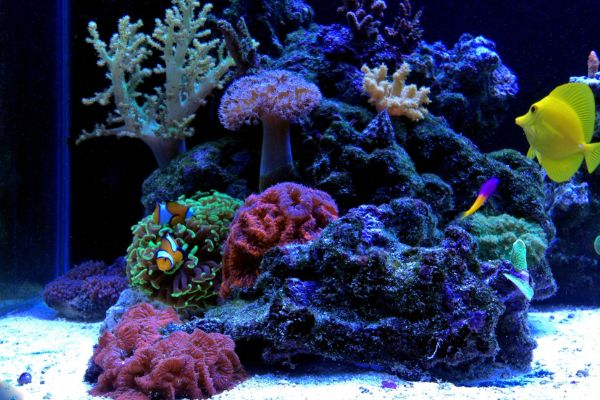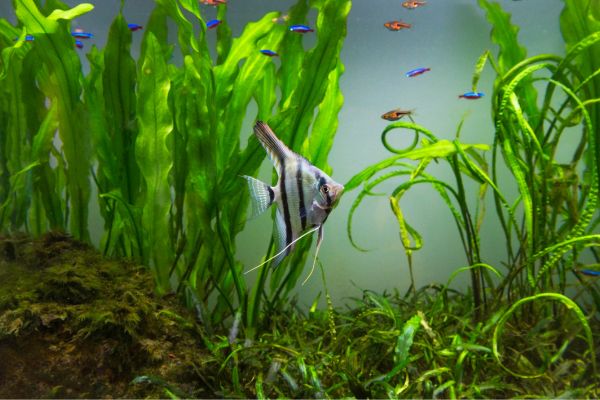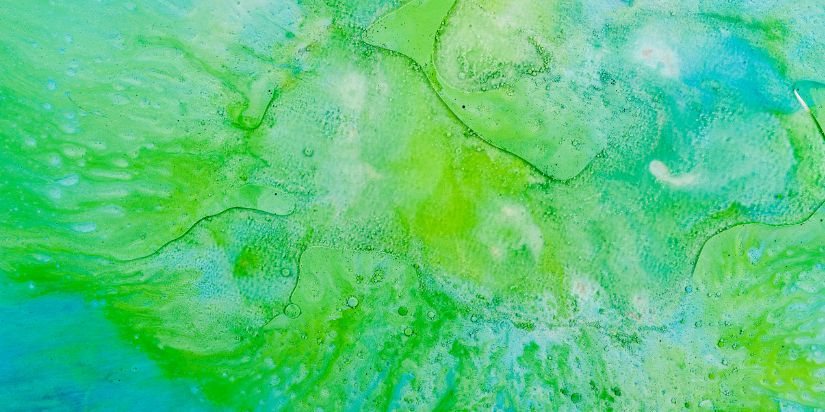Every aquarist aims for a vibrant, colorful, lively aquarium to look at and excite the senses. A healthy tank offers a sense of elegance and peace to any room in your home or office. However, if algae growth gets out of control, your aquarium could be left looking slimy, murky, and disgusting. Not only is this an eyesore, but it can also cause unnecessary stress. Unfortunately, quick fixes like siphoning won’t help, either. To truly rid your aquarium of nuisance algae problems, you must apply fish tank cleaning service habits that resolve the underlying issues.
Whether you’re dealing with filamentous “matted algae,” planktonic “pea soup algae,” or branched algae like Chara, excess algae growth is a recurring problem, and you need a long-term plan to fight it. Below, we provide a simple yet comprehensive guide on removing problematic algae growth during your fish tank cleaning service.
For a more comprehensive look at maintaining your aquarium, see our guide here.
Reduce Excess Light
Like all greenery, algae thrive off light and need a lot of it to survive. If you’re having algae growth problems, you might be saturating your tank with high light levels. This creates an environment that caters to the algae and helps them grow, filling your tank with murky water.
Cutting back on lighting can be an effective and simple first step in using fish tank cleaning service habits to combat algae levels.
Don’t have plants or coral in your fish tank that rely on a lot of light? Consider cutting lighting to four hours daily or less to reduce the risks of nuisance algae problems. Some of your fish may even enjoy the low-light conditions. For example, cichlids show good color in dim, ambient light.
However, aquarists with plants in their aquariums still need to maintain high light levels. In that case, a popular method for dealing with algae growth is to turn off the lights for one or two hours in the middle of the day. Plants can deal with this, but algae will have their growth interrupted.
Finally, watch out for direct sunlight. Exposure makes algae grow wildly. If your aquarium must be near sunlight, try blocking it out with backing paper or a structured internal background.

Eliminate Excess Nutrients
Excess nutrients are another factor that fuels algae growth. Algae grow by consuming nutrients like phosphates and nitrates, which are produced by your aquarium inhabitants, including fish, crustaceans, and mollusks. Poor fish tank cleaning service habits result in excess nutrient buildup, which encourages excess algae growth, so correcting those issues is key.
Factors that contribute to excess nutrient buildup include:
- Inadequate water changes and poor fish tank cleaning service habits
- Poor water circulation
- Using an improper water top-off source like tap water
- Using a low-quality sea salt mix
- Lack of natural algae-eating predators
To start solving the issue, use test kits to get readings for your phosphate and nitrate levels. This will give you a better idea of what you’re dealing with. Then, tackle the problem with these potential aquarium maintenance fixes:
- Use a protein skimmerto remove excess dissolved organic compounds (DOCs) that algae feed on.
- Perform water changes to help dilute the nutrients, especially in smaller systems where larger or more frequent changes are practical.
- Only top off your water supply with reverse osmosis (RO) or deionized (DI) water.
- Alternatively, use purified water with nitrate and phosphate removal resins.
- If algae persist, test for elevated levels of silicates. If excess silicates are present, use a deionizer to remove them.
- Alter your feeding habits to prevent overfeeding, which contributes to excess nutrients becoming an ongoing problem.
- Consider removing big, messy fish that produce lots of phosphate and require bigger, dirtier filters.
Introduce Predators and Competition
Finally, you may want to enlist some help fighting your algae problem. Add inhabitants that eat algae or compete for the same resources to help keep algae from spreading throughout your aquarium.
Competition for Nutrients
There’s a wide variety of organisms available that will outcompete algae for nutrients and leave them unable to get a foothold in the tank. For example, aquatic plants will take up nitrates, phosphates, trace elements and macros that would otherwise feed algae. Heavy planting is a practical step in aquarium maintenance to combat excess algae.
Similarly, macro algae like Caulerpa (seaweeds) and kelp use nutrients in the same way. You can place them in a refugium, a secondary tank connected to your aquarium. The refugium contains macroalgae, invertebrates, and other organisms that can’t stay in the main tank since your fish would eat them. When water passes through the refugium, those organisms consume nutrients and remove them from the water column, depriving algae of the nutrients they need to grow.

Predators Who Eat Algae
Many species of organisms actively feed on algae, helping you keep its growth under control. These fall into a few different categories, including:
- Fish—The lawnmower and bicolor blenny remove algae from surfaces like glass. Tangs and Surgeonfishes can keep both microalgae and macroalgae in check. Other fish you may not normally consider include mollies and angelfish.
- Herbivores—Many snails like turbos and nerites will eat algae while patrolling your tank. Small hermit crabs like the opportunistic blue-legged hermit crab are prized by some reefkeepers for how well they seek out and crop algae.
- Detritivores—Starfishes, marine worms, and sea cucumbers contribute to removing specific types of excess algae.
Pay attention to what types of algae each of these eats. Choose one that matches the types of algae you’re having issues with and consider whether they’ll fit well with the rest of your aquarium inhabitants.
Consider a Professional Fish Tank Cleaning Service
It takes a lot of work to keep an aquarium growing, thriving and algae-free. If you’re feeling overwhelmed with your tank’s care, consider hiring a professional fish tank cleaning service. Professionals have the skills, education, tools and time necessary to prevent algae growth and keep your tank looking its best.
Each company may offer slightly different services during their standard aquarium maintenance. At Living Art Aquatics, we:
- Check fish for disease and swimming behavior
- Take a headcount of your fish
- Test filters, lights, heaters and other apparatus
- Remove algae from pipes
- Perform water chemistry tests
- Complete appropriate water changes
- Replenish salt and buffers
- Clean and service filters
- Check temperature
- Adjust pumps and skimmers
- Replace or rinse any filters (as appropriate)
- Clean decorative items
- Wipe cabinetry
- Fill auto feeders and check frozen food
Need additional maintenance? Ask us when you call to schedule an appointment! In some cases, we can perform special fish tank cleaning service tasks during our routine calls!
Need More Fish Tank Cleaning Service Tips and Advice?
Maybe you’re having trouble figuring out which of these is causing your algae issues or what fish tank cleaning service habits would be appropriate to try. Perhaps you’ve tried some of these and are still having trouble or want to make sure you prevent future algae problems. In these cases, it’s essential you consult an expert to get a professional opinion.
At Living Art Aquatics, we’ve been designing artistic seascapes and performing professional aquarium maintenance in Crystal Lake, IL and the Chicago area for decades. We have the professional expertise necessary to accurately evaluate your algae problem and prescribe fish tank cleaning service habits that work.
Call us today at (847) 737-5151 and make your algae issues a thing of the past!
Editors Note: This blog was originally published in October of 2017 and was updated in January of 2024.







